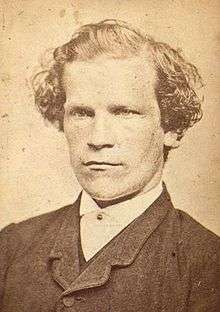Franz Müller
Franz Müller (31 October 1840 – 14 November 1864), was a German tailor who was hanged for the murder of Thomas Briggs, the first killing on a British train. The case caught the imagination of the public due to increasing safety fears about rail travel at the time, and the pursuit of Müller across the Atlantic Ocean to New York by Scotland Yard.
Franz Müller | |
|---|---|
 | |
| Born | 31 October 1840 |
| Died | 14 November 1864 (aged 24) London, England |
| Nationality | German |
| Occupation | Tailor |
| Criminal charge(s) | Murder |
| Criminal penalty | Death by hanging |
| Criminal status | Executed |
Crime
On 9 July 1864, Thomas Briggs, a 69-year-old City banker, was beaten and robbed while he travelled on the 9.50pm North London Railway train from Fenchurch Street to Chalk Farm. The assailant took his gold watch and gold watch chain, but left £5 in Briggs's pockets, and threw him from the compartment. Just after 10.00pm, the driver of a train travelling in the opposite direction spotted Briggs lying on the embankment next to the tracks between the old Bow and Victoria Park & Hackney Wick stations,[1] described as "his foot towards London and his head towards Hackney, at a spot about two-thirds of the distance 1 mile 414 yards between Bow and Hackney stations". Briggs died of his wounds shortly after being taken to the nearby Mitford Castle public house (now named Top o' the Morning) on Cadogan Terrace.[2]
Investigation
When the train reached Hackney Wick, the guard was alerted by two bankers who discovered pools of blood in Briggs' compartment. Police later found a black beaver hat.[3] Initially it was presumed to have belonged to the deceased but it subsequently turned out to have belonged to the murderer.
On 18 July, a cab driver called Matthews came forward with suspicions about a German man known as Franz Müller.[4] He told police that the 24-year-old tailor had come to his house with a gold chain in a box. After he had attached his fob watch to the chain, Matthews gave the box to his daughter. The box had been sold by a jeweller in Cheapside. The jeweller identified Müller from a photograph and told investigators that the German had visited his shop on 11 July to exchange a gold chain. This was later identified as belonging to Briggs. With this evidence, a warrant for Müller's arrest was issued.[5]
Transatlantic escape
However, by the time an arrest warrant was issued, Müller had boarded a sailing ship, the Victoria, to New York. On 20 July, Richard Tanner, a Scotland Yard inspector,[6][7] along with Matthews and the jeweller sailed for New York from Liverpool on the Inman steamer City of Manchester in pursuit of Müller. The faster ship arrived in New York three weeks before Müller.
When Müller finally arrived in Manhattan on 25 August he was arrested. Among his possessions was Briggs's gold watch and a hat. He had altered the hat by cutting the crown by half its height and carefully sewing it to the brim.[8] An American judge upheld the extradition request to return Müller to Britain.
Trial and conviction
Much of the evidence against Müller was circumstantial, but prosecutor Mr Serjeant Ballantine made a strong case. Defence claims that Matthews had come forward only to receive the reward had little effect. Müller maintained his innocence throughout his three-day trial at the Old Bailey. After he was found guilty, he was sentenced to death.[9] King Wilhelm I of Prussia (subsequently the Kaiser of Germany) failed to get the British Government to postpone Müller's execution.[10]
Death
The public hanging of Müller took place outside Newgate Prison in London on 14 November amid scenes of drunkenness and disorderly conduct by 50,000 spectators. Although this was one of the last public executions in England, they did not end until 1868.
Despite consistently claiming innocence at his trial and while awaiting sentence, Müller reportedly confessed to the crime immediately before being hanged. Dr Louis Cappel, the German-speaking Lutheran pastor appointed to attend the prisoner, claimed afterwards that Müller's last words (in German) were "Ich habe es getan" ("I did it") in response to the question, was he responsible for the death of Briggs.[11][12]
Legacy
Briggs had been murdered in a closed compartment that had no corridor, so after the train started there was no way to leave until the next station.[13] Public reaction resulted in the establishment of the communication cord on trains that allowed passengers to contact members of the railway crew, required by the Regulation of Railways Act 1868. It also led to the creation of railway carriages with side corridors, which allowed passengers to move from their compartments while the train was in motion. Old compartment stock was modified by some companies to include circular peep-holes in the partitions.
References
- Knott, George. Trial of Franz Muller. 1911. Butterworth & Co (Internet Archive). Retrieved 17 February 2013.
- Colquhoun (2011) pp. 20, 25
- Colquhoun (2011) pp.1-5
- Colquhoun (2011) p. 66
- Colquhoun (2011) p. 85
- Thompson, Ed (2012-11-29). "The First Railway Murder in Britain". British Transport Police History Group. Retrieved 9 November 2014.
- Knott, George H. (1911). Trial Of Franz Muller. BUTTERWORTH & CO. (INDIAN). LTD. ( NEW ZEALAND). LTD. (AUSTRALIA). LTD. p. 67.
- "The Murder On The North London Railway." Times [London, England] 31 Oct. 1864: 7+. The Times Digital Archive. Web. 29 Oct. 2018.
- Colquhoun (2011) pp. 235-37
- Colquhoun (2011) p. 262
- Colquhoun (2011) p. 268
- Knott (1911) xxi; pp. 187-88
- Fletcher, p. 53
Bibliography
- Colquhoun, Kate (2011). Mr Briggs' Hat: A Sensational Account of Britain's First Railway Murder. London, UK: Little, Brown. ISBN 978-0-7481-1567-9.
- James Gardner, The First British Railway Murder. 2013
- Fletcher, James Ogden, Railways in Their Medical Aspects, London: J E Cornish, 1867 OCLC 931282661.